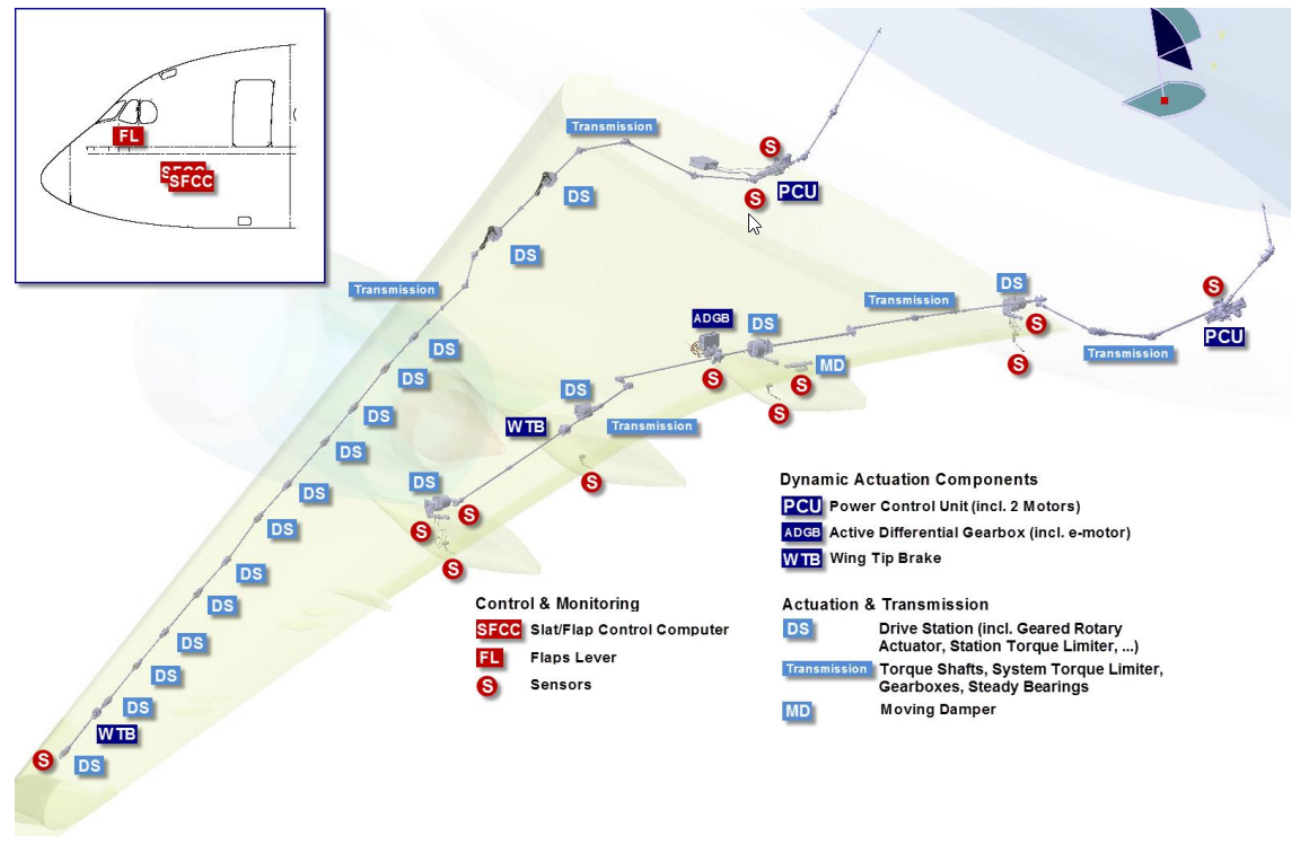这是一位读者 "后街洋芋" 之前的提问,由于个人经常想不清楚逻辑类问题,所以断断续续思考和咨询空客,到最近才确定,实在不好意思。
在 AUTO FLT FMS 1+2 FAULT 程序中,要关闭 TAWS FLAPS MODE:
从 DSC-34-SURV-20-20 E TAWS - CONTROLS AND INDICATORS 中可知,这个按钮就是抑制 GPWS mode 4B 的 TOO LOW FLAPS 警告.
那问题就变成了,在两部 FMS 失效的情况下,为什么要抑制 GPWS MODE 4B 的 TOO LOW FLAPS 警告?一个衍生问题是,为什么这个按钮只抑制 4B,而不管 4A 和 4C ?
首先来看 MODE 4 是什么?在 DSC-34-SURV-20-10 B TAWS - SYSTEM DESCRIPTION B 对 MODE 4 有描述,分为 A, B, C 三个子模式。其中 MODE 4A 和 MODE 4B 是用于进近,而 MODE 4C 是对 MODE 3 的补充,用于起飞和爬升阶段。
1. 4A: LANDING GEAR UP AND FLAPS NOT IN LANDING CONFIGURATION (MODE 4A)
2. 4B: LANDING GEAR DOWN AND FLAPS NOT IN LANDING CONFIGURATION, OR LANDING GEAR UP AND FLAPS IN LANDING CONFIGURATION (MODE 4B)
3. 4C: LANDING GEAR UP OR FLAPS NOT IN LANDING CONFIGURATION (MODE 4C)
逻辑关系分解如下(不考虑飞行阶段):
| Case | Landing Gear | Flap Configuration | Mode 4A | Mode 4B | Mode 4C |
| 1 | Down | Landing | No | No | No |
| 2 | Down | Not Landing | No | Yes | Yes |
| 3 | Up | Landing | No | Yes | Yes |
| 4 | Up | Not Landing | Yes | No | Yes |
空客回复说,与襟翼位置相关的信息有两个:
- HLS (High Lift System) 的实际襟翼位置
- MFD PERF 页面选择的着陆构型
对于 MODE 4B,当这两个信息不匹配时,就意味着“不在着陆构型”。比如出现襟缝翼卡阻时,襟翼无法放到 3 或者全,必然不在着陆构型,所以需要关闭 FLAP MODE 按钮。
两部 FMS 失效的问题在于,会导致 AESS 接收不到“选择的着陆构型”。实际构型放到 3 或者全了,但 AESS 不知道选的是哪个,可能会以为与实际襟翼位置不符,从而触发 TOO LOW FLAP 警告。所以也需要关闭 FLAP MODE 按钮。
而 MODE 4C 并不接收 MFD 中“选择的着陆构型”,只依靠 HLS 的实际襟翼位置,所以不存在不匹配导致假警告的问题。
关于为什么不把 MODE 4B 也设计成只依靠 HLS 的实际襟翼位置的逻辑,空客表示,从安全角度来看,触发 4B 的假警告并不是很大的威胁,而修改逻辑需要重新的 AESS 标准,目前并没有这个计划。不过以空客的尿性,说不定哪天就改了……
至于 4A,我没有问,是因为对于起落架收上的情况(参见上表 CASE3 和 CASE4),无论襟翼构型如何,4A 和 4B 都会触发一个,4C 也都会触发,所以不存在误触发和不触发的问题。
原文
Q1:
In the procedure of AUTO FLT FMS 1+2 FAULT, [MFD SURV] TAWS FLAPS MODE is request to set OFF. According to FCOM description, this action can inhibit GPWS mode 4B.
Even loss of FMS position, TAWS can computes it's own geometric position, the envelope of mode 4B will not change. So why do we need to set TAWS FLAPS MODE OFF?
A1:
In the Abnormal Procedure AUTO FLT FMS 1+2 FAULT, the TAWS FLAPS MODE is requested to set to OFF because in case of FMS 1+2 fault, the AESS (Aircraft Environment Surveillance System) cannot receive the Slats/Flaps configuration selected for landing and may trigger spurious TOO LOW FLAPS alerts.
Q2:
In the TAWS (Terrain Awareness and Warning System) system description (DSC-34-SURV-20-10 B), MODE 4 is divided into three sub-modes: A, B, and C.
1. 4A: Landing gear up and flaps not in landing configuration
2. 4B: Landing gear down and flaps not in landing configuration, or landing gear up and flaps in landing configuration
3. 4C: Landing gear up or flaps not in landing configuration
From a logical perspective using "AND" and "OR" conjunctions, 4C's "OR" condition encompasses both 4A and 4B:
Logical Comparison Table:
| Case | Landing Gear | Flap Configuration | Mode 4A | Mode 4B | Mode 4C |
| 1 | Down | Landing | No | No | No |
| 2 | Down | Not Landing | No | Yes | Yes |
| 3 | Up | Landing | No | Yes | Yes |
| 4 | Up | Not Landing | Yes | No | Yes |
In this table:
- Mode 4A triggers only when the landing gear is up and the flaps are not in the landing configuration (Case 4).
- Mode 4B triggers when either the landing gear is down and the flaps are not in the landing configuration (Case 2), or the landing gear is up and the flaps are in the landing configuration (Case 3).
- Mode 4C triggers when either the landing gear is up (Cases 3 and 4) or the flaps are not in the landing configuration (Cases 2 and 4).
Potential False Warnings:
If both FMS units fail and the AESS (Aircraft Environmental Surveillance System) cannot receive the flap status, a false warning could be triggered in Case 2. Disabling the FLAP MODE only suppresses Mode 4B, preventing false warnings during approach, but a go-around might still trigger a false warning in Mode 4C.
A2:
The design is different between GPWS mode 4B and mode 4C for the Slats/Flaps position source of information.
The information of the Slats/Flaps landing position from the FMS is only used by GPWS mode 4B. That is why, in the Abnormal Procedure FMS 1+2 FAULT, the TAWS FLAPS MODE is requested to be set to OFF, in order to inhibit GPWS mode 4B, and to avoid spurious TOO LOW FLAPS alerts during the landing.
The GPWS mode 4C is activated in climb, and does not use the Slats/Flaps position information from the FMS but from the HLS. Thus, in case of FMS 1+2 FAULT, the GPWS mode 4C is working properly, and does not need to be inhibited.
Q3:
Thanks for the explanation. And what is HLS? And now that HLS can transfer slats/flaps info to GPWS in mode 4C, why not apply it in mode 4B to avoid spurious TOO LOW FLAPS alerts when FMS 1+2 FAULT.
A3:
The “HLS” designates the high lift system, which is used to control the high lift devices on the wings.
It encompasses the following sub-systems:
Please be advised that the FMS landing configuration is a Boolean for which the value depends on the selection of the landing configuration (i.e. CONF 3 selected) on the MFD. The AESS already consolidates this data with the HLS position in order to identify that the aircraft in an actual landing condition (note: this condition cannot be revealed by the solely interpretation of the HLS position).
Besides, it appears that the dual failure of the FMS may, in some very remote conditions, induce an erroneous value of the landing configuration parameter, which would therefore result lead to the spurious triggering of the “TOO LOW FLAPS” alert if the altitude criteria (RA) is also satisfied.
Although a degraded mode in order only to rely on the HLS data if a total loss of the FMS occurs has not been considered in the original design of the AESS (which would have suppressed a risk of spurious alerts in this failure mode), it shall be known that a spurious mode 4B alerting is only considered as minor from a safety perspective. Based on this, and considering that modification of the surveillance logic would require a brand new AESS standard, such a modification is not retained internally.
翻译:
请注意,FMS 着陆配置是一个布尔值,其取值取决于在 MFD 上选择的着陆配置(即选择 CONF 3)。AESS 已经将此数据与 HLS 位置整合在一起,以识别飞机处于实际着陆状态(注意:仅通过解释 HLS 位置无法揭示这种情况)。
此外,在极其罕见的情况下,FMS 的双重故障可能会导致着陆配置参数的错误值,从而在满足高度标准(RA)时引发错误的“TOO LOW FLAPS”警报。
尽管在原始设计中未考虑仅依赖 HLS 数据以应对 FMS 完全丧失的降级模式(这将消除在这种故障模式下误警报的风险),但需要知道的是,误触发模式4B 警报在安全性角度来看只被认为是次要的。基于此,考虑到修改监视逻辑将需要一个全新的 AESS 标准,因此内部不保留这种修改。
Q4:
Combining both responses in 81391526/010 and 015, my understanding is as follows:
The HLS knows the actual position of the slats/flaps, while the FMS knows the landing flap position set by the crew in the MFD. Mode 4B requires both pieces of information, meaning the actual configuration must match what is set in the MFD, otherwise it is considered "not in landing configuration."
On the other hand, Mode 4C considers "not in landing configuration" as long as it is not in configuration 3 or 4. In other words, as long as it is in configuration 3 or 4, Mode 4C will not be activated, regardless of whether the settings in the MFD match the actual position.
Is my understanding correct?
A4:
Your understanding is perfectly correct for the mode 4B.
For the mode 4C, the FMS landing configuration is not used, which also means that “TOO LOW TERRAIN” is not expected in climb, even if a total loss of the FMS has occurred.




